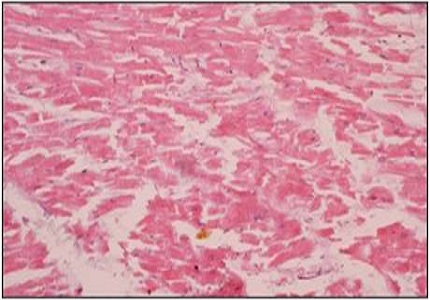A study of the histopathological changes in heart in electrocution deaths
Abstract
Introduction: One of the biggest challenges faced by forensic pathologists is death due to electrocution. In almost half of all cases no gross pathological findings can be seen. The history surrounding the cause of death and circumstantial evidence is sometimes ambiguous and possesses great difficulty.
Aim: To study the various histopathological changes in heart in electrocution. Methods and materials: In the present study, a total of 15 heart specimens in electrocution deaths and 15 normal heart specimens are considered during the study period of one year from 2015 to 2016. Case details are obtained from the records and analyzed. The histopathological findings are recorded in a proforma.
Results: Myofibre break-up, separation of sarcomeres and extravasation of RBCs are found in all the 15 cases of electrocution (100%). The other findings are disarray of the myofibres (87%), hyper contracted myocyte with squaring of nuclei (73%), myocellular segmentation (33%) and myocyte vacuolization (20%).
Conclusion: The histopathological changes in heart definitely provide an additional clue in the diagnosis of electrocution deaths. Most of the histopathological changes in heart are found consistently in electrocution cases compared to that of the normal hearts. Hence, their presence can be relied upon in the diagnosis of electrocution deaths and in reducing the number of negative autopsies.
Downloads
References
2. Vishwakanth B, Shruthi P. Low voltage electrocution deaths and histopathological findings: One-year prospective autopsy study. J. Curr. Forensic Sci Res. 2015;1(2):1-5.
3. Fineschi V, Di Donato S,Mondillo S, Turillazzi E. Electric shock: Cardiac effects relativetonon fatal injuries and post-mortem findings in fatal cases. Int J Cardiol. 2006;111(1):6-11. DOI: https://doi.org/10.1016/j.ijcard.2005.07.060. [PubMed]
4. Zipes DP. Electrophysiological mechanisms involved in ventricular fibrillation. Circulation 1975 Dec; 52(6):120-30.
5. Ku CS, Lin SL, Hsu TL, Wang SP, Chang MS. Myocardial damage associated with electrical injury. Am Heart J. 1989;118(3): 621-4. DOI: http://dx.doi.org/10.1016/0002-8703(89)90283-4
6. Koumbourlis AC. Electrical injuries. Crit Care Med. 2002;30(11):24-30. DOI:http://dx.doi.org/10.1097/00003246-200211001-00007.
7. Lewin RF, Arditti A, Sclarovsky S. Non-invasive evaluation of electrical cardiac injury. Br Heart J. 1983; 49:190-2. DOI: http://dx.doi.org/10.1136/hrt.49.2.190
8. James TN, Riddick L, Embry JH. Cardiac abnormalities demonstrated post-mortem in four cases of accidental electrocution and their potential significance relative to nonfatal electrical injuries of the heart. Am Heart J. 1990 Jul;120(1):143-57. DOI: https://doi.org/10.1016/0002-8703(90)90171-S. [PubMed]
9. Romero B, Candell-Riera J, Gracia RM, Fernandez MA, Aquade S, Peracaula R et al. Myocardial necrosis by electrocution: evaluation ofnon-invasive methods.JNuclMed 1997;38(2):250-1.
10. Fineschi V, Karch SB, D’Errico S, Pomara C, Riezzo I, Turillazzi E. Cardiac pathology in death from electrocution. Int J Legal Med. 2006 Mar;120(2):79-82. DOI: https://doi.org/10.1007/s00414-005-0011-8. [PubMed]
11. Uzun I, Akyildiz E. Histopathological differentiation of skin lesions caused by electrocution, flame burns and abrasion. Forensic Sci Int. 2008; 178(2-3): 157-61. DOI: http://dx.doi.org/10.1016/j.forsciint.2008.03.012
12. Fontanarosa PB. Electrical shock and lightning strikes. Ann Emerg Med. 1993;22(2):378-87. DOI: http://dx.doi.org/10.1016/S0196-0644(05)80468-8. [PubMed]
13. Stanca L, Zavoi R, Marinescu AM, NiculescuM, Stanculescu D. Cardiac morphological changes in electrocution. Rom J Leg Med 2007;15(2):100-5. DOI: https://doi.org/10.4323/rjlm.2007.100
14. Vanderwee MA, Humphrey SM, Gavin JB, Armiger LC. Changes in the contractile state, fine structure and metabolism of cardiac muscle cells during the development of rigor mortis. Virchows Arch B Cell Pathol Incl Mol Pathol. 1981;35(2):159-67. DOI: 10.1007/BF02889156.
15. Baroldi G, Silver MD, Parolini M, Pomara C, Turillazzi E, Fineschi V. Myofiber break-up: a marker of ventricular death. Int J Cardiol. 2005;100(3):435-41. [PubMed]
16. Luo BT, Zhao YH, Chen XY, Jiang HG. Pathology of accidental electrocution: an autopsy study of 16 cases. Chinese J Pathol. 2009 Jun;38(6):380-3. DOI: 10.3760/cma.j.issn.0529-5807.2009.06.006.
17. Dabas N, Bakkannavar SM, Bhat S, Palimra V. Microscopic cardiacchanges in an electrocution death. J Punjab Acad Forensic Med Toxicol. 2015;15(2):93-6.
18. Tanaka N, Kinoshita, Jamal M, Kumihashi M, Tsutsui K, AmenoK. Findings for current marks: histopathological examination and energy-dispersive X-ray spectroscopy of three cases. Leg Med. 2013 Sep;15(5):283-7. DOI: https://doi.org/10.1016/j.legalmed.2013.06004. [PubMed]
19. Aggrawal A. Textbook of forensic medicine and toxicology, 1st ed. APC India (P) Ltd.;2014.



 OAI - Open Archives Initiative
OAI - Open Archives Initiative


